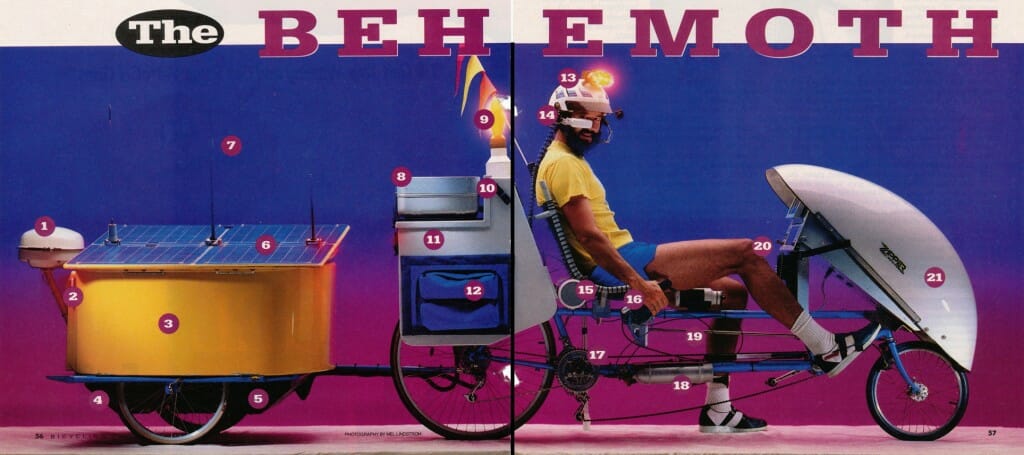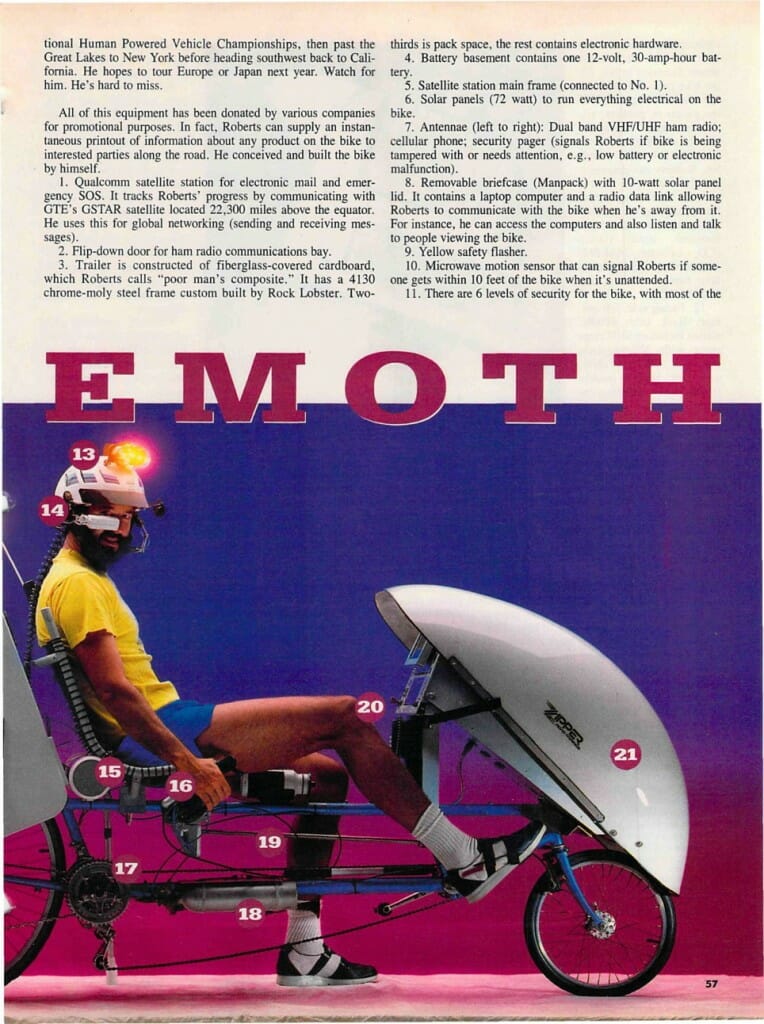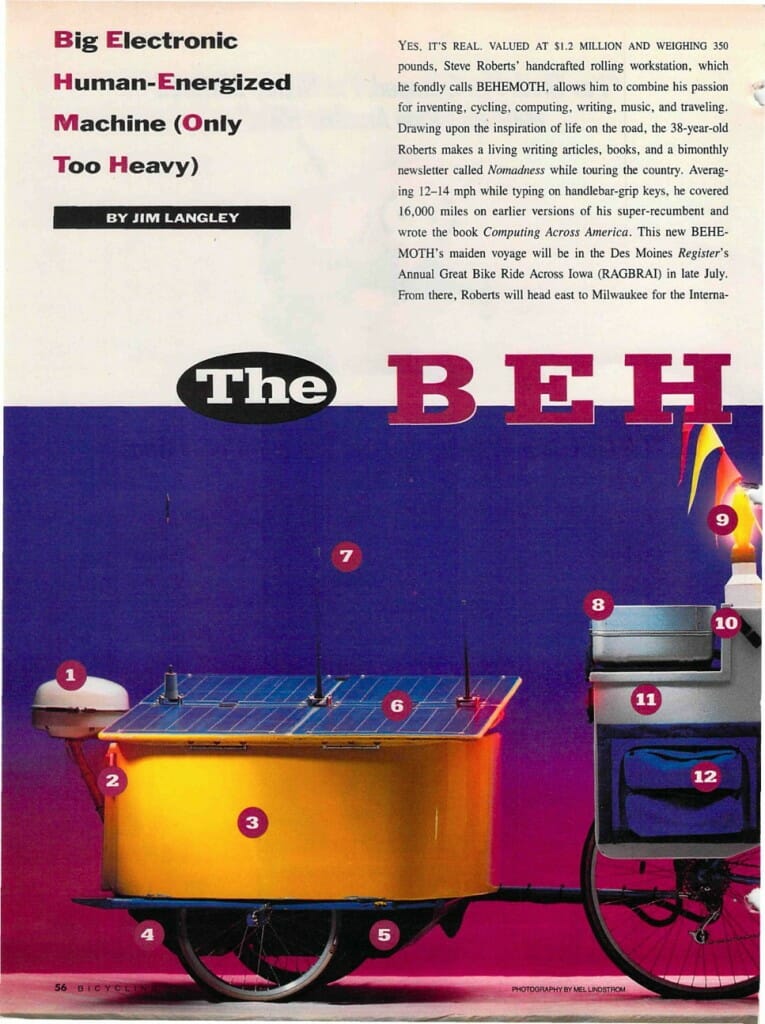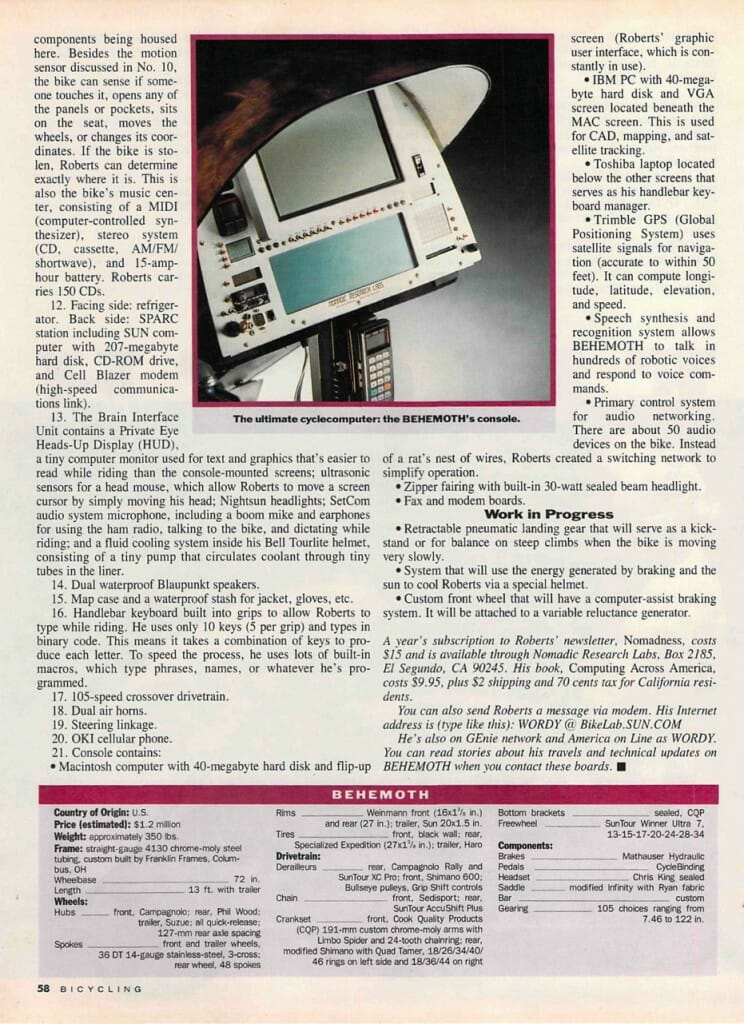
The BEHEMOTH – Bicycling Magazine
This was a significant article in the annals of BEHEMOTH. It came out while I was on the road in the summer of ’91, struggling to get my body back in shape while dealing with a machine that was a lot heavier than I had anticipated.
The photo was taken in the Palo Alto studio of Mel Lindstrom. Painting with light, he bid me hold still on a platform in front of a white sweep… then cut the room lights and opened the shutter of a 4×5 camera. He held blue/violet gels in front of the lens and triggered strobes on the backdrop, using me as a shadow mask. He then strobed the foreground subject, and urging me to remain still, continued the exposure for a few seconds to allow the bike’s lights to burn in.
It’s also a very unusual article for Bicycling, which normally focused on racing. I am the precise opposite of a racer, and the tech description of the bike in this context is delightful. My only regret is that it was still many months from completion, and lots of things changed from the description with others conspicuously absent in the photo (cabling from the console, custom fairing, fully integrated cellular phone, landing gear system…).
Big Electronic Human-Energized Machine (Only Too Heavy)
by Jim Langley
Bicycling
August, 1991
Photos by Mel Lindstrom
YES. IT’S REAL. VALUED AT $1.2 MILLION AND WEIGHING 350 pounds, Steve Roberts’ handcrafted rolling workstation, which he fondly calls BEHEMOTH, allows him to combine his passion for inventing, cycling, computing, writing, music, and traveling.
Drawing upon the inspiration of life on the road, the 38-year-old Roberts makes a living writing articles, books, and a bimonthly newsletter called Nomadness while touring the country. Averaging 12-14 mph while typing on handlebar-grip keys, he covered 16,000 miles on earlier versions of his super-recumbent and wrote the book Computing Across America. This new BEHEMOTH’S maiden voyage will be in the Des Moines Register’s Annual Great Bike Ride Across Iowa (RAGBRAI) in late July. From there, Roberts will head east to Milwaukee for the International Human Powered Vehicle Championships, then past the Great Lakes to New York before heading southwest back to California. He hopes to tour Europe or Japan next year. Watch for him. He’s hard to miss.

All of this equipment has been donated by various companies for promotional purposes. In fact, Roberts can supply an instantaneous printout of information about any product on the bike to interested parties along the road. He conceived and built the bike by himself. (NOTE: I had lots of brilliant volunteers without whom the project would have been impossible.)
1. Qualcomm satellite station for electronic mail and emergency SOS. It tracks Roberts’ progress by communicating with GTE’s GSTAR satellite located 22,300 miles above the equator. He uses this for global networking (sending and receiving messages).
2. Flip-down door for ham radio communications bay.
3. Trailer is constructed of fiberglass-covered cardboard, which Roberts calls “poor man’s composite.” It has a 4130 chrome-moly steel frame custom built by Rock Lobster. Two-thirds is pack space, the rest contains electronic hardware.
4. Battery basement contains one 12-volt, 30-amp-hour battery.
5. Satellite station main frame (connected to No. 1).
6. Solar panels (72 watt) to run everything electrical on the bike.
7. Antennae (left to right): Dual band VHF/UHF ham radio; cellular phone; security pager (signals Roberts if bike is being tampered with or needs attention, e.g., low battery or electronic malfunction).
8. Removable briefcase (Manpack) with 10-watt solar panel lid. It contains a laptop computer and a radio data link allowing Roberts to communicate with the bike when he’s away from it. For instance, he can access the computers and also listen and talk to people viewing the bike.
9. Yellow safety flasher.
10. Microwave motion sensor that can signal Roberts if someone gets within 10 feet of the bike when it’s unattended.
11. There are 6 levels of security for the bike, with most of the components being housed here. Besides the motion sensor discussed in No. 10, the bike can sense if someone touches it, opens any of the panels or pockets, sits on the seat, moves the wheels, or changes its coordinates. If the bike is stolen, Roberts can determine exactly where it is. This is also the bike’s music center, consisting of a MIDI (computer-controlled synthesizer), stereo system (CD, cassette, AM/FM/ shortwave), and 15-amp-hour battery. Roberts carries 150 CDs.
12. Facing side: refrigerator. Back side: SPARC station including SUN computer with 207-megabyte hard disk, CD-ROM drive, and Cell Blazer modem (high-speed communications link).
13. The Brain Interface Unit contains a Private Eye Heads-Up Display (HUD). A tiny computer monitor used for text and graphics that’s easier to read while riding than the console-mounted screens; ultrasonic sensors for a head mouse, which allow Roberts to move a screen cursor by simply moving his head; Nightsun headlights; SetCom audio system microphone, including a boom mike and earphones for using the ham radio, talking to the bike, and dictating while riding; and a fluid cooling system inside his Bell Tourlite helmet, consisting of a tiny pump that circulates coolant through tiny tubes in the liner.
14. Dual waterproof Blaupunkt speakers.
15. Map case and a waterproof stash for jacket, gloves, etc.
16. Handlebar keyboard built into grips to allow Roberts to type while riding. He uses only 10 keys (5 per grip) and types in binary code. This means it takes a combination of keys to produce each letter. To speed the process, he uses lots of built-in macros, which type phrases, names, or whatever he’s programmed.
17. 105-speed crossover drivetrain.
18. Dual air horns.
19. Steering linkage.
20. OKI cellular phone.
21. Console contains:
- Macintosh computer with 40-megabyte hard disk and flip-up screen (Roberts’ graphic user interface, which is constantly in use).
- IBM PC with 40-megabyte hard disk and VGA screen located beneath the MAC screen. This is used for CAD, mapping, and satellite tracking.
- Toshiba laptop located below the other screens that serves as his handlebar keyboard manager.
- Trimble GPS (Global Positioning System) uses satellite signals for navigation (accurate to within 50 feet). It can compute longitude, latitude, elevation, and speed.
- Speech synthesis and recognition system allows BEHEMOTH to talk in hundreds of robotic voices and respond to voice commands.
- Primary control system for audio networking. There are about 50 audio devices on the bike. Instead of a rat’s nest of wires, Roberts created a switching network to simplify operation.
- Zipper fairing with built-in 30-watt sealed beam headlight.
- Fax and modem boards.
Work in Progress
- Retractable pneumatic landing gear that will serve as a kickstand or for balance on steep climbs when the bike is moving very slowly.
- System that will use the energy generated by braking and the sun to cool Roberts via a special helmet.
- Custom front wheel that will have a computer-assist braking system. It will be attached to a variable reluctance generator.






You must be logged in to post a comment.